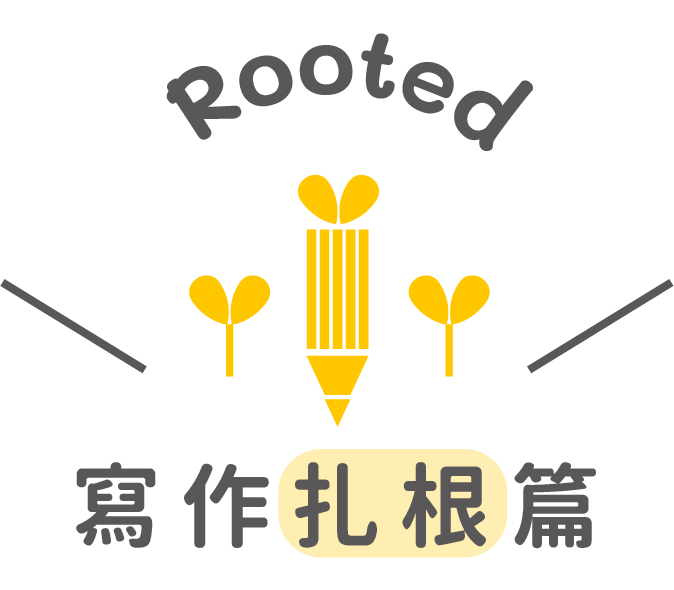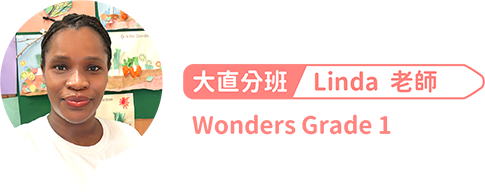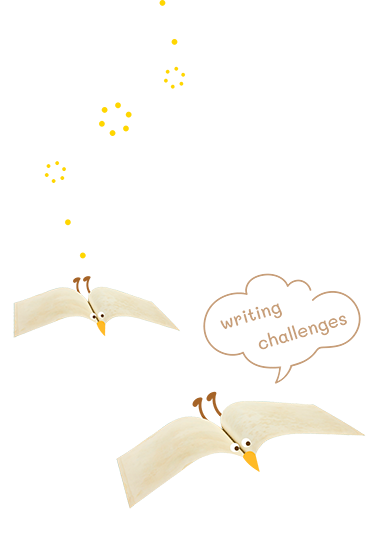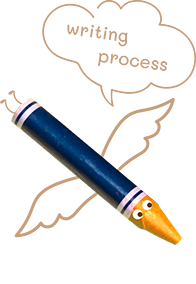



How do you prepare or guide Grade 1 students to go from writing sentences to writing a well-thought-out paragraph?

Imagine being a first grader, stepping into the “big school” for the first time, with the teacher speaking in an unfamiliar language. That could be intimidating. The most important step before any learning takes place is to ease students’ anxiety. I usually try to make them feel comfortable coming to class and enjoy being with me by finding out how much they already know, and other things like their interests and dislikes. I use simple language, supplemented with illustrations and various forms of expressions. I pay attention to what excites and bothers my students. Then we engage in conversations about Pokemon, NBA, Queen card, and other subjects that spark their interest. When students are willing to share a topic, our first step of writing is done. The most challenging part of any writing is the “idea”! Once there is the need to express, all the other steps are simply technical that students can be trained to do.

What are some of your favourite writing activities and what makes them preferred?

I had a Starter Advanced class last year. It had been quite some time since I had taught students of such a beginner level. This group of students essentially just knew their ABCs when I started with them and took home the ability to write sentences independently after 11 months. I was very proud. What happened? Sight words and sentences! We began learning fundamental sight words needed in "Classroom English." Students learned to recognize and spell them. Then we practiced spelling vocabulary. Three weeks after 10 new vocabulary words were taught, students then practiced sentence-making. I started with giving an example sentence to explain the word. Then we practiced substituting some keywords with other items to generate different ideas. After verbal practice, students were encouraged to write their own sentences. At first, it took like forever for students to make their 10 sentences. Whenever they constructed a perfect sentence on their own, I praised them for their wonderful writing skills. After a few rounds, students grew confidence and were able to write more.


What writing difficulties do students typically encounter at this level and how do you help your student overcome these challenges?

At this level, students typically encounter several writing challenges. Firstly, students often have a limited vocabulary, struggling to find the appropriate words to express their thoughts and spell out those words correctly. Additionally, forming complete sentences with proper grammar and punctuation poses difficulties. They may struggle to organize their ideas coherently and logically connect different parts of their writing. Furthermore, adding enough relevant details to support their ideas and make their writing interesting is another obstacle they often encounter. Lastly, they may find it challenging to use transition words to smoothly link different parts of their writing.
To support students in overcoming these challenges, I utilize a range of strategies. Vocabulary building is encouraged through reading and discussions. I also provide modeling of correct sentence structure and grammar using examples. Visual tools like graphic organizers help them organize their thoughts. Encouraging the use of descriptive language with adjectives and adverbs enhances the richness of their writing. Regular feedback and shared writing experiences help them understand their mistakes and learn how ideas can be effectively presented. Additionally, reading their writing aloud assists in identifying errors and awkward phrasing. By addressing these issues, students can typically improve their writing abilities.

Reading is the core of Cat’s Curriculum. How can reading help promote a student’s writing ability?

Reading serves as a powerful tool for improving students' writing skills in numerous ways. When they read different genres of stories, they learn various vocabulary words, which they may apply to make their writing more interesting. Reading also shows them how to make good sentences with proper grammar. They learn how paragraphs and essays are structured, which can help make their own writing clearer. Exposure to various types of writing while reading allows them to experiment with different writing styles. Also, the ideas they find in what they read can inspire their own writing. Reading helps them understand how to connect their ideas smoothly, so their writing flows better. Additionally, reading enhances their critical thinking skills. They learn to look at things from different perspectives and express their thoughts. Another point to make is that reading stories from different places and cultures helps them utilize their imagination and learn things that they may have not been aware of. Therefore, reading serves as a fundamental tool for writing, providing students with words, ideas, and techniques to enhance their writing. That's why reading is a big help for getting better at writing.


Writing at higher levels is often understood as only crafting essays. What other writing forms are done in class? Explain one in depth.

I enjoy working on both short and longer descriptive writing pieces with my students. Shorter ones involve key vocabulary words we learn in class. I usually give students a topic and some words to create a story. I establish some guidelines and ask them to incorporate these into their writing. Longer pieces are the creative works we do in our Skills Handbook (SHB). I often encourage my students to show rather than tell in these writing activities. A reader is usually more engaged in your story when you describe your characters, setting, and events through sensory details and actions. I also remind my students to think about their choice of words. Powerful words can create more impactful moods and images.

To ensure students enjoy their class time, how do you keep writing activities enjoyable and fun?

To keep writing enjoyable and fun, I brainstorm with my students first. I provide my own examples or invite them to share their ideas. I also provide them with what-if situations to get them started on their thinking process. With more extensive projects, I put students into groups to brainstorm. Then I ask them to share their ideas with the class. I always aim to create a student-centered learning environment where they can learn from each other. However, sometimes I do get more reserved students. For students who need more time to process information, I pair them with more outgoing students. This approach helps them feel less under the spotlight, while still allowing them to work on their tasks.

This might be a bit tricky to put into words, but let’s give it a shot: what’s your greatest classroom moment involving a student’s writing?

For me, the greatest writing moment involving a student's writing happened during the writing process. I used to care about the result, but now I have come to realize that the process is just as important, if not more. I take joy in watching students form ideas, discuss them with me, and then jot them down in their graphic organizers. These are the moments where I can see their creativity take place, the joy they get when they talk about their ideas, and the moment of discovering a great idea.

As a teacher, if you had to give your students only one invaluable writing tip, what would that be?

Writing always takes time and planning. I tell my students this every time we begin a piece of writing. Some ideas just don't come naturally, and that's okay. Ideas do take time to develop and slowly form in our minds. My best advice to all my students is "plan first." If you have a plan, putting things into paragraphs will become easier. This method works for everyone. I also have several "free-spirited" students in my class for whom planning is not usually their first instinct. They often have a natural ability to pull exciting ideas out of thin air, which is impressive and fun. While spontaneous creativity can generate ideas, these ideas often require a more solution-oriented approach to refine. Once they start planning, their writing becomes much more organized and clear. Planning helps them focus, build depth, and most importantly, it allows them to ensure that their ideas connect and make sense in the end.


Writing at higher levels is often understood as only crafting essays. What other writing forms are done in class? Explain one in depth.

Five-paragraph essays are important, and we do practice them in class. However, there are a myriad of genres and writing forms that should be explored. Fiction remains a popular one among students, but even within fiction, there are different sub-genres (science fiction, magical realism, horror, fables...I could go on and on). There’s also non-fiction, of course. Students usually don’t enjoy non-fiction writing as much, but my GV-3 class thoroughly enjoyed drafting Model United Nations (MUN) resolutions, position papers, and background guides.
MUN is a student-led conference that emulates the United Nations (UN) and has been popular for decades. My GV-3 class ran a semester-long workshop where they did individual research on a country and its position on the Taliban takeover of Afghanistan in 2020. The students were initially surprised by the bullet-point-heavy format of MUN resolutions and found it challenging to write in the specific language required for MUN. However, by the end they became so adept at using parliamentary language that they were able to compose their counterarguments on the spot during debates.

To ensure students enjoy their class time, how do you keep writing activities enjoyable and fun?

Gamifying writing tasks is oftentimes a good way to start the creative process. For example, I have played a game where students each write one sentence and craft a story as a class together. Of course, the story needs to get refined, but with everyone’s input there are already a few characters, settings, and sometimes really good conflicts to draw inspiration from.
With non-fiction writing, I try to go off the textbook and connect writing prompts to things happening around students. This requires them to do some research online (which can be articles, YouTube videos, or social media posts). Students feel more accomplished when they have something to share with each other and with me. Sometimes, I even learn something new from the students’ research.

What writing activity you – and perhaps your students – can’t get enough of?

Madlibs! I love madlibs. It’s a writing exercise that gets students moving around the classroom asking each other for adjectives, verbs, nouns, etc. I use this exercise to help them to practice their word choice. Simple words like “good, bad, nice, great” are off the table, but pretty much nothing else is. You’d be surprised by how many “fantastic cockroaches” and equally bizarre characters show up in those fill-in-the-blank stories.
A more advanced variation of madlibs is this blind story creation game I play with older students. We try to come up with the next sentence of the story just by reading the previous line. There is a strict structure that makes sure the story comes to an end in 10 sentences or less. This is usually done as a class brainstorming activity to get the creative juices flowing. Again, one of the stories ended up with cockroaches overrunning Taichung.

This might be a bit tricky to put into words, but let’s give it a shot: what’s your greatest classroom moment involving a student’s writing?

I think one of the greatest classroom moments was when my GV-1 students finished their fiction stories after reading Number the Stars. Each of them willingly worked on their stories at home, and many asked for extensions because they wanted to refine their stories. While they all wrote fiction, each was vastly different from the other. A student wrote a chilling thriller that reminded me of Agatha Christie’s books; another wrote a page-turning fable that taught readers not to be greedy. There was some really advanced language and descriptions used in those stories. This wasn’t because we had a list of figurative language they needed to use. While writing, many of them would look up more complex descriptions online and share their findings with each other. I remember them constantly asking each other things like, "What's another way of saying things in a terrified way?” or “What's another way of saying something while doing an action?” For me, it’s the effort and care for their pieces of writing that’s most heartwarming to me. We had a small reading circle after they had finished their stories and they were all genuinely impressed with each other's story (and so was I!).

As a teacher, if you had to give your students only one invaluable writing tip, what would that be?

You don’t have to start from the beginning. Start from the middle or even the end. It doesn’t matter as long as you finish the whole thing. I never start any of my writing from the beginning. Sometimes it’s easier to draft the body paragraphs for informative essays and then tie it all together to the conclusion and introduction. It’s the same for fiction stories. Sometimes, a scene may come to you with no beginning or end. Write that down first and the rest will follow. In its own right, it’s actually pretty fun. Sometimes it feels like you’re writing the story as much as the story is writing itself.





How do you prepare or guide Grade 1 students to go from writing sentences to writing a well-thought-out paragraph?

Imagine being a first grader, stepping into the “big school” for the first time, with the teacher speaking in an unfamiliar language. That could be intimidating. The most important step before any learning takes place is to ease students’ anxiety. I usually try to make them feel comfortable coming to class and enjoy being with me by finding out how much they already know, and other things like their interests and dislikes. I use simple language, supplemented with illustrations and various forms of expressions. I pay attention to what excites and bothers my students. Then we engage in conversations about Pokemon, NBA, Queen card, and other subjects that spark their interest. When students are willing to share a topic, our first step of writing is done. The most challenging part of any writing is the “idea”! Once there is the need to express, all the other steps are simply technical that students can be trained to do.

What are some of your favourite writing activities and what makes them preferred?

I had a Starter Advanced class last year. It had been quite some time since I had taught students of such a beginner level. This group of students essentially just knew their ABCs when I started with them and took home the ability to write sentences independently after 11 months. I was very proud. What happened? Sight words and sentences! We began learning fundamental sight words needed in "Classroom English." Students learned to recognize and spell them. Then we practiced spelling vocabulary. Three weeks after 10 new vocabulary words were taught, students then practiced sentence-making. I started with giving an example sentence to explain the word. Then we practiced substituting some keywords with other items to generate different ideas. After verbal practice, students were encouraged to write their own sentences. At first, it took like forever for students to make their 10 sentences. Whenever they constructed a perfect sentence on their own, I praised them for their wonderful writing skills. After a few rounds, students grew confidence and were able to write more.


What writing difficulties do students typically encounter at this level and how do you help your student overcome these challenges?

At this level, students typically encounter several writing challenges. Firstly, students often have a limited vocabulary, struggling to find the appropriate words to express their thoughts and spell out those words correctly. Additionally, forming complete sentences with proper grammar and punctuation poses difficulties. They may struggle to organize their ideas coherently and logically connect different parts of their writing. Furthermore, adding enough relevant details to support their ideas and make their writing interesting is another obstacle they often encounter. Lastly, they may find it challenging to use transition words to smoothly link different parts of their writing.
To support students in overcoming these challenges, I utilize a range of strategies. Vocabulary building is encouraged through reading and discussions. I also provide modeling of correct sentence structure and grammar using examples. Visual tools like graphic organizers help them organize their thoughts. Encouraging the use of descriptive language with adjectives and adverbs enhances the richness of their writing. Regular feedback and shared writing experiences help them understand their mistakes and learn how ideas can be effectively presented. Additionally, reading their writing aloud assists in identifying errors and awkward phrasing. By addressing these issues, students can typically improve their writing abilities.

Reading is the core of Cat’s Curriculum. How can reading help promote a student’s writing ability?

Reading serves as a powerful tool for improving students' writing skills in numerous ways. When they read different genres of stories, they learn various vocabulary words, which they may apply to make their writing more interesting. Reading also shows them how to make good sentences with proper grammar. They learn how paragraphs and essays are structured, which can help make their own writing clearer. Exposure to various types of writing while reading allows them to experiment with different writing styles. Also, the ideas they find in what they read can inspire their own writing. Reading helps them understand how to connect their ideas smoothly, so their writing flows better. Additionally, reading enhances their critical thinking skills. They learn to look at things from different perspectives and express their thoughts. Another point to make is that reading stories from different places and cultures helps them utilize their imagination and learn things that they may have not been aware of. Therefore, reading serves as a fundamental tool for writing, providing students with words, ideas, and techniques to enhance their writing. That's why reading is a big help for getting better at writing.











How do you prepare or guide Grade 1 students to go from writing sentences to writing a well-thought-out paragraph?
Imagine being a first grader, stepping into the “big school” for the first time, with the teacher speaking in an unfamiliar language. That could be intimidating. The most important step before any learning takes place is to ease students’ anxiety. I usually try to make them feel comfortable coming to class and enjoy being with me by finding out how much they already know, and other things like their interests and dislikes. I use simple language, supplemented with illustrations and various forms of expressions. I pay attention to what excites and bothers my students. Then we engage in conversations about Pokemon, NBA, Queen card, and other subjects that spark their interest. When students are willing to share a topic, our first step of writing is done. The most challenging part of any writing is the “idea”! Once there is the need to express, all the other steps are simply technical that students can be trained to do.
What are some of your favourite writing activities and what makes them preferred?
I had a Starter Advanced class last year. It had been quite some time since I had taught students of such a beginner level. This group of students essentially just knew their ABCs when I started with them and took home the ability to write sentences independently after 11 months. I was very proud. What happened? Sight words and sentences! We began learning fundamental sight words needed in "Classroom English." Students learned to recognize and spell them. Then we practiced spelling vocabulary. Three weeks after 10 new vocabulary words were taught, students then practiced sentence-making. I started with giving an example sentence to explain the word. Then we practiced substituting some keywords with other items to generate different ideas. After verbal practice, students were encouraged to write their own sentences. At first, it took like forever for students to make their 10 sentences. Whenever they constructed a perfect sentence on their own, I praised them for their wonderful writing skills. After a few rounds, students grew confidence and were able to write more.











What writing difficulties do students typically encounter at this level and how do you help your student overcome these challenges?
At this level, students typically encounter several writing challenges. Firstly, students often have a limited vocabulary, struggling to find the appropriate words to express their thoughts and spell out those words correctly. Additionally, forming complete sentences with proper grammar and punctuation poses difficulties. They may struggle to organize their ideas coherently and logically connect different parts of their writing. Furthermore, adding enough relevant details to support their ideas and make their writing interesting is another obstacle they often encounter. Lastly, they may find it challenging to use transition words to smoothly link different parts of their writing.
To support students in overcoming these challenges, I utilize a range of strategies. Vocabulary building is encouraged through reading and discussions. I also provide modeling of correct sentence structure and grammar using examples. Visual tools like graphic organizers help them organize their thoughts. Encouraging the use of descriptive language with adjectives and adverbs enhances the richness of their writing. Regular feedback and shared writing experiences help them understand their mistakes and learn how ideas can be effectively presented. Additionally, reading their writing aloud assists in identifying errors and awkward phrasing. By addressing these issues, students can typically improve their writing abilities.
Reading is the core of Cat’s Curriculum. How can reading help promote a student’s writing ability?
Reading serves as a powerful tool for improving students' writing skills in numerous ways. When they read different genres of stories, they learn various vocabulary words, which they may apply to make their writing more interesting. Reading also shows them how to make good sentences with proper grammar. They learn how paragraphs and essays are structured, which can help make their own writing clearer. Exposure to various types of writing while reading allows them to experiment with different writing styles. Also, the ideas they find in what they read can inspire their own writing. Reading helps them understand how to connect their ideas smoothly, so their writing flows better. Additionally, reading enhances their critical thinking skills. They learn to look at things from different perspectives and express their thoughts. Another point to make is that reading stories from different places and cultures helps them utilize their imagination and learn things that they may have not been aware of. Therefore, reading serves as a fundamental tool for writing, providing students with words, ideas, and techniques to enhance their writing. That's why reading is a big help for getting better at writing.


Benjamin Franklin:
Either write something worth reading or do something worth writing.


Writing at higher levels is often understood as only crafting essays. What other writing forms are done in class? Explain one in depth.

I enjoy working on both short and longer descriptive writing pieces with my students. Shorter ones involve key vocabulary words we learn in class. I usually give students a topic and some words to create a story. I establish some guidelines and ask them to incorporate these into their writing. Longer pieces are the creative works we do in our Skills Handbook (SHB). I often encourage my students to show rather than tell in these writing activities. A reader is usually more engaged in your story when you describe your characters, setting, and events through sensory details and actions. I also remind my students to think about their choice of words. Powerful words can create more impactful moods and images.

To ensure students enjoy their class time, how do you keep writing activities enjoyable and fun?

To keep writing enjoyable and fun, I brainstorm with my students first. I provide my own examples or invite them to share their ideas. I also provide them with what-if situations to get them started on their thinking process. With more extensive projects, I put students into groups to brainstorm. Then I ask them to share their ideas with the class. I always aim to create a student-centered learning environment where they can learn from each other. However, sometimes I do get more reserved students. For students who need more time to process information, I pair them with more outgoing students. This approach helps them feel less under the spotlight, while still allowing them to work on their tasks.

This might be a bit tricky to put into words, but let’s give it a shot: what’s your greatest classroom moment involving a student’s writing?

For me, the greatest writing moment involving a student's writing happened during the writing process. I used to care about the result, but now I have come to realize that the process is just as important, if not more. I take joy in watching students form ideas, discuss them with me, and then jot them down in their graphic organizers. These are the moments where I can see their creativity take place, the joy they get when they talk about their ideas, and the moment of discovering a great idea.

As a teacher, if you had to give your students only one invaluable writing tip, what would that be?

Writing always takes time and planning. I tell my students this every time we begin a piece of writing. Some ideas just don't come naturally, and that's okay. Ideas do take time to develop and slowly form in our minds. My best advice to all my students is "plan first." If you have a plan, putting things into paragraphs will become easier. This method works for everyone. I also have several "free-spirited" students in my class for whom planning is not usually their first instinct. They often have a natural ability to pull exciting ideas out of thin air, which is impressive and fun. While spontaneous creativity can generate ideas, these ideas often require a more solution-oriented approach to refine. Once they start planning, their writing becomes much more organized and clear. Planning helps them focus, build depth, and most importantly, it allows them to ensure that their ideas connect and make sense in the end.


Writing at higher levels is often understood as only crafting essays. What other writing forms are done in class? Explain one in depth.

Five-paragraph essays are important, and we do practice them in class. However, there are a myriad of genres and writing forms that should be explored. Fiction remains a popular one among students, but even within fiction, there are different sub-genres (science fiction, magical realism, horror, fables...I could go on and on). There’s also non-fiction, of course. Students usually don’t enjoy non-fiction writing as much, but my GV-3 class thoroughly enjoyed drafting Model United Nations (MUN) resolutions, position papers, and background guides.
MUN is a student-led conference that emulates the United Nations (UN) and has been popular for decades. My GV-3 class ran a semester-long workshop where they did individual research on a country and its position on the Taliban takeover of Afghanistan in 2020. The students were initially surprised by the bullet-point-heavy format of MUN resolutions and found it challenging to write in the specific language required for MUN. However, by the end they became so adept at using parliamentary language that they were able to compose their counterarguments on the spot during debates.

To ensure students enjoy their class time, how do you keep writing activities enjoyable and fun?

Gamifying writing tasks is oftentimes a good way to start the creative process. For example, I have played a game where students each write one sentence and craft a story as a class together. Of course, the story needs to get refined, but with everyone’s input there are already a few characters, settings, and sometimes really good conflicts to draw inspiration from.
With non-fiction writing, I try to go off the textbook and connect writing prompts to things happening around students. This requires them to do some research online (which can be articles, YouTube videos, or social media posts). Students feel more accomplished when they have something to share with each other and with me. Sometimes, I even learn something new from the students’ research.

What writing activity you – and perhaps your students – can’t get enough of?

Madlibs! I love madlibs. It’s a writing exercise that gets students moving around the classroom asking each other for adjectives, verbs, nouns, etc. I use this exercise to help them to practice their word choice. Simple words like “good, bad, nice, great” are off the table, but pretty much nothing else is. You’d be surprised by how many “fantastic cockroaches” and equally bizarre characters show up in those fill-in-the-blank stories.
A more advanced variation of madlibs is this blind story creation game I play with older students. We try to come up with the next sentence of the story just by reading the previous line. There is a strict structure that makes sure the story comes to an end in 10 sentences or less. This is usually done as a class brainstorming activity to get the creative juices flowing. Again, one of the stories ended up with cockroaches overrunning Taichung.

This might be a bit tricky to put into words, but let’s give it a shot: what’s your greatest classroom moment involving a student’s writing?

I think one of the greatest classroom moments was when my GV-1 students finished their fiction stories after reading Number the Stars. Each of them willingly worked on their stories at home, and many asked for extensions because they wanted to refine their stories. While they all wrote fiction, each was vastly different from the other. A student wrote a chilling thriller that reminded me of Agatha Christie’s books; another wrote a page-turning fable that taught readers not to be greedy. There was some really advanced language and descriptions used in those stories. This wasn’t because we had a list of figurative language they needed to use. While writing, many of them would look up more complex descriptions online and share their findings with each other. I remember them constantly asking each other things like, "What's another way of saying things in a terrified way?” or “What's another way of saying something while doing an action?” For me, it’s the effort and care for their pieces of writing that’s most heartwarming to me. We had a small reading circle after they had finished their stories and they were all genuinely impressed with each other's story (and so was I!).

As a teacher, if you had to give your students only one invaluable writing tip, what would that be?

You don’t have to start from the beginning. Start from the middle or even the end. It doesn’t matter as long as you finish the whole thing. I never start any of my writing from the beginning. Sometimes it’s easier to draft the body paragraphs for informative essays and then tie it all together to the conclusion and introduction. It’s the same for fiction stories. Sometimes, a scene may come to you with no beginning or end. Write that down first and the rest will follow. In its own right, it’s actually pretty fun. Sometimes it feels like you’re writing the story as much as the story is writing itself.
Either write something worth reading or do something worth writing. ——Benjamin Franklin













Writing at higher levels is often understood as only crafting essays. What other writing forms are done in class? Explain one in depth.
I enjoy working on both short and longer descriptive writing pieces with my students. Shorter ones involve key vocabulary words we learn in class. I usually give students a topic and some words to create a story. I establish some guidelines and ask them to incorporate these into their writing. Longer pieces are the creative works we do in our Skills Handbook (SHB). I often encourage my students to show rather than tell in these writing activities. A reader is usually more engaged in your story when you describe your characters, setting, and events through sensory details and actions. I also remind my students to think about their choice of words. Powerful words can create more impactful moods and images.
To ensure students enjoy their class time, how do you keep writing activities enjoyable and fun?
To keep writing enjoyable and fun, I brainstorm with my students first. I provide my own examples or invite them to share their ideas. I also provide them with what-if situations to get them started on their thinking process. With more extensive projects, I put students into groups to brainstorm. Then I ask them to share their ideas with the class. I always aim to create a student-centered learning environment where they can learn from each other. However, sometimes I do get more reserved students. For students who need more time to process information, I pair them with more outgoing students. This approach helps them feel less under the spotlight, while still allowing them to work on their tasks.
This might be a bit tricky to put into words, but let’s give it a shot: what’s your greatest classroom moment involving a student’s writing?
For me, the greatest writing moment involving a student's writing happened during the writing process. I used to care about the result, but now I have come to realize that the process is just as important, if not more. I take joy in watching students form ideas, discuss them with me, and then jot them down in their graphic organizers. These are the moments where I can see their creativity take place, the joy they get when they talk about their ideas, and the moment of discovering a great idea.
As a teacher, if you had to give your students only one invaluable writing tip, what would that be?
Writing always takes time and planning. I tell my students this every time we begin a piece of writing. Some ideas just don't come naturally, and that's okay. Ideas do take time to develop and slowly form in our minds. My best advice to all my students is "plan first." If you have a plan, putting things into paragraphs will become easier. This method works for everyone. I also have several "free-spirited" students in my class for whom planning is not usually their first instinct. They often have a natural ability to pull exciting ideas out of thin air, which is impressive and fun. While spontaneous creativity can generate ideas, these ideas often require a more solution-oriented approach to refine. Once they start planning, their writing becomes much more organized and clear. Planning helps them focus, build depth, and most importantly, it allows them to ensure that their ideas connect and make sense in the end.















Writing at higher levels is often understood as only crafting essays. What other writing forms are done in class? Explain one in depth.
Five-paragraph essays are important, and we do practice them in class. However, there are a myriad of genres and writing forms that should be explored. Fiction remains a popular one among students, but even within fiction, there are different sub-genres (science fiction, magical realism, horror, fables...I could go on and on). There’s also non-fiction, of course. Students usually don’t enjoy non-fiction writing as much, but my GV-3 class thoroughly enjoyed drafting Model United Nations (MUN) resolutions, position papers, and background guides.
MUN is a student-led conference that emulates the United Nations (UN) and has been popular for decades. My GV-3 class ran a semester-long workshop where they did individual research on a country and its position on the Taliban takeover of Afghanistan in 2020. The students were initially surprised by the bullet-point-heavy format of MUN resolutions and found it challenging to write in the specific language required for MUN. However, by the end they became so adept at using parliamentary language that they were able to compose their counterarguments on the spot during debates.
To ensure students enjoy their class time, how do you keep writing activities enjoyable and fun?
Gamifying writing tasks is oftentimes a good way to start the creative process. For example, I have played a game where students each write one sentence and craft a story as a class together. Of course, the story needs to get refined, but with everyone’s input there are already a few characters, settings, and sometimes really good conflicts to draw inspiration from.
With non-fiction writing, I try to go off the textbook and connect writing prompts to things happening around students. This requires them to do some research online (which can be articles, YouTube videos, or social media posts). Students feel more accomplished when they have something to share with each other and with me. Sometimes, I even learn something new from the students’ research.
What writing activity you – and perhaps your students – can’t get enough of?
Madlibs! I love madlibs. It’s a writing exercise that gets students moving around the classroom asking each other for adjectives, verbs, nouns, etc. I use this exercise to help them to practice their word choice. Simple words like “good, bad, nice, great” are off the table, but pretty much nothing else is. You’d be surprised by how many “fantastic cockroaches” and equally bizarre characters show up in those fill-in-the-blank stories.
A more advanced variation of madlibs is this blind story creation game I play with older students. We try to come up with the next sentence of the story just by reading the previous line. There is a strict structure that makes sure the story comes to an end in 10 sentences or less. This is usually done as a class brainstorming activity to get the creative juices flowing. Again, one of the stories ended up with cockroaches overrunning Taichung.
This might be a bit tricky to put into words, but let’s give it a shot: what’s your greatest classroom moment involving a student’s writing?
I think one of the greatest classroom moments was when my GV-1 students finished their fiction stories after reading Number the Stars. Each of them willingly worked on their stories at home, and many asked for extensions because they wanted to refine their stories. While they all wrote fiction, each was vastly different from the other. A student wrote a chilling thriller that reminded me of Agatha Christie’s books; another wrote a page-turning fable that taught readers not to be greedy. There was some really advanced language and descriptions used in those stories. This wasn’t because we had a list of figurative language they needed to use. While writing, many of them would look up more complex descriptions online and share their findings with each other. I remember them constantly asking each other things like, "What's another way of saying things in a terrified way?” or “What's another way of saying something while doing an action?” For me, it’s the effort and care for their pieces of writing that’s most heartwarming to me. We had a small reading circle after they had finished their stories and they were all genuinely impressed with each other's story (and so was I!).
As a teacher, if you had to give your students only one invaluable writing tip, what would that be?
You don’t have to start from the beginning. Start from the middle or even the end. It doesn’t matter as long as you finish the whole thing. I never start any of my writing from the beginning. Sometimes it’s easier to draft the body paragraphs for informative essays and then tie it all together to the conclusion and introduction. It’s the same for fiction stories. Sometimes, a scene may come to you with no beginning or end. Write that down first and the rest will follow. In its own right, it’s actually pretty fun. Sometimes it feels like you’re writing the story as much as the story is writing itself.





